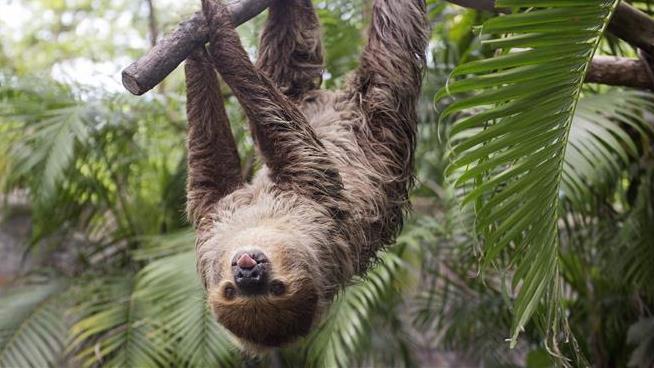Torrance coyote trapper investigated for possible violation of state law
Reply

https://www.newser.com/story/350387/costa-rica-finally-does-away-with-public-zoos.html
Its final 2 state zoos have closed
| By Kate Seamons, Newser StaffPosted May 15, 2024 1:40 PM CDT |





“Captivity is only justified when animals cannot return to the forest for either physical or behavioral problems that prevent them from living in freedom”—a stance that obviously clashes with the concept of a zoo. It’s Costa Rica’s stance, with that line said in a Saturday video posted to Facebook by its minister of environment and energy in announcing the country’s last two state zoos have closed. It’s a move a long time coming, reports the New York Times: In 2013, Costa Rica banned the keeping of wildlife in captivity, intending to shutter government-funded zoos in 2014. But Fundazoo, the foundation that operated them, put up a legal fight.
story continues below
61 Shockingly Bizarre Gifts Nobody Would Think OfWeird & wonderful gifts you’d never think to buy. In stock. Free shipping on many.Unforgettable GadgetsShop Now
That appears to have reached its end. The Ministry of Environment and Energy on Saturday said Fundazoo’s contract, which expired Friday, was not renewed, allowing the closure of the Simón Bolívar Zoo and the Santa Ana Conservation Center. Eighteen private zoos in the country are unaffected. As for the 287 animals held in the last two public zoos—a jaguar, crocodiles, spider monkeys, and a sloth among them, per the Tico Times—they’ll be evaluated by biologists and vets, quarantined, and either returned to the wild or placed in an animal sanctuary. (Something noteworthy happened in one of the zoos last year.)

RBC UkraineFollow
114.8K Followers
Story by Liliana Oleniak
• 17h • 2 min read

A powerful magnetic storm hits the Earth (collage: RBC-Ukraine)© RBC-Ukraine
The powerful geomagnetic storm that recently hit the Earth has already caused radio and GPS to malfunction. Scientists emphasize that it can also cause a wave of hurricanes and storms.
RBC-Ukraine explains what theory the researchers have put forward, what it is based on, and whether the consequences of the magnetic storm threaten Ukrainians.
Savings AccountsBig Banks Are Offering Record High CD Interest Rates – Up to 12%!
Sources: Daily Mail, Meteoagent, National Oceanic and Atmospheric Administration (NOAA).
Researchers’ theory
According to a recent study, a solar storm that hits the Earth can cause hurricanes and storms.
As part of their work, a team of scientists used a model that:
・studied the activity of tropical cyclones over the past 5500 years
・identified 11 time periods when there were 40% more storms on Earth than usual
The only common feature of these periods was extreme solar activity.
Scientists’ theory is that when the sun is overly active, it sends more energy to the Earth, which heats the oceans and becomes fuel for tropical storms.
Right now, the United States is in the midst of the so-called hurricane season, but given the solar activity, it could be a record-breaking one.

Scientists sound alarm over powerful geomagnetic storm engulfing Earth© RBC-Ukraine
An active sunspot in May 2024 (screenshot: youtube.com/@noaanationalweatherservice)
Geomagnetic storms impact on Earth’s orbit and surface
The National Oceanic and Atmospheric Administration (NOAA) also reported that geomagnetic storms can affect infrastructure in Earth orbit and on the Earth’s surface.
Related video: NOAA Issues Rare Warning Following Powerful Solar Event (Dailymotion)
According to experts, such solar activity can significantly affect communications, power grids, navigation, radio, and satellite operations.
Professor Yang Wang from Florida State University clarified that it is not always easy to predict the impact of the Sun on the Earth’s surface. Therefore, it is not worthwhile to say definitively that the geomagnetic storm will increase the number of tropical cyclones this year.
She adds that the role of solar activity in modulating tropical cyclone activity is complex.
“As the oceans warm up, they have more energy available to be converted into tropical cyclone winds, thus creating more favorable conditions for the development of stronger storms,” she explains.
The scientists note that solar activity can be an important driver of climate variability and tropical cyclone activity through its effects on atmospheric circulation, ocean currents, and sea surface temperatures.

Scientists sound alarm over powerful geomagnetic storm engulfing Earth© RBC-Ukraine
The Sun’s influence on the Earth (infographic: meteoagent.com)
Is there threat to Ukrainians?
Given that Ukraine is located relatively far from the ocean, it is unlikely to be threatened by tropical cyclones or powerful hurricanes.
At the same time, many studies conducted by scientists point to a possible relationship between magnetic storms and human activity.
Savings AccountsBig Banks Are Offering Record High CD Interest Rates – Up to 12%!
The point is that super-powerful solar energy can negatively affect a person’s mood and well-being.
Some people emphasize that health can deteriorate during magnetic storms, with headaches, heart problems, sleep disturbances, and weakness.
Earlier, we wrote that the planet was covered by a powerful red magnetic storm of the highest level.
Read also about magnetic storms in May – what days you should take care of your health.
May 15, 2024 6:30 PM EDT
https://www.pbs.org/newshour/show/why-scientists-are-concerned-about-the-latest-transmission-of-bird-flu-to-cows
By —
By —
Sam WeberLeave your feedbackShare
Share on FacebookShare on Twitter
The outbreak of bird flu in the U.S. has alarmed researchers and prompted new efforts to track the virus that’s already killed millions of birds from Europe to Antarctica. As H5N1 continues to jump into mammals, many scientists are concerned that we’re not watching closely enough as this virus spreads. William Brangham reports. A warning: This story contains scenes of animals in distress.
Notice: Transcripts are machine and human generated and lightly edited for accuracy. They may contain errors.
BY SAUL ELBEIN – 05/15/24 3:10 PM ET
SHAREPOST https://thehill.com/newsletters/sustainability/4665901-studies-find-contagious-bird-flu-in-major-american-cities/
Video Player is loading.
https://imasdk.googleapis.com/js/core/bridge3.640.0_en.html#goog_493480167
Advertisement: 0:14

 Sustainability The Big Story Studies find contagious bird flu in major American cities Recent discoveries of a highly contagious bird flu in American cities are raising concerns that it could spark the next pandemic. Sustainability The Big Story Studies find contagious bird flu in major American cities Recent discoveries of a highly contagious bird flu in American cities are raising concerns that it could spark the next pandemic. © AP Photo/Guadalupe PardoThe viral strain H5N1 has been present in New York City birds for at least two years, according to findings published on Wednesday in the Journal of Virology. Student volunteers swabbing captive birds and smears of bird poop in the winter of 2021 found six cases of the infectious virus H5N1 in Canada geese, raptors and (in a case that surprised researchers) a rogue chicken. © AP Photo/Guadalupe PardoThe viral strain H5N1 has been present in New York City birds for at least two years, according to findings published on Wednesday in the Journal of Virology. Student volunteers swabbing captive birds and smears of bird poop in the winter of 2021 found six cases of the infectious virus H5N1 in Canada geese, raptors and (in a case that surprised researchers) a rogue chicken. H5N1 is the strain of flu — common in wild birds — that concerns health researchers because of the danger that it can jump to mammals. The virus has been found in 36 dairy herds across 9 U.S. states since late March, according to Reuters. The New York City study only found the virus in six very sick birds, which in and of itself isn’t shocking — only a tiny proportion of those sampled carried the disease, which in any case is common in wild bird populations. But recent evidence raises concerns that the virus could become established in human populations. It sickened a dairy worker in Texas in March, who scientists now know contracted the disease from one of the cattle. Scientists in Texas have also found the full viral genome of H5N1 in wastewater from nine cities — 90 percent of those sampled, according to a preprint study from Baylor University. In 82 percent of the Texas sites studied, levels of H5N1 exceeded levels of seasonal flu, the scientists wrote in the study. The discovery of the virus in domesticated animals raises “substantial concerns that viral adaptation” to humans without exposure to the virus could incubate “the next flu pandemic,” the authors wrote. Those results are not yet peer-reviewed, and the results suggested that the source of the virus in wastewater was runoff from birds or cattle — although scientists said that the possibility that it had come from humans couldn’t be ruled out. “Many people are wondering how we can monitor this H5N1 situation,” Mike Tisza, one of the Texas workers, wrote on X. “We sequence the whole virome from wastewater, and, well, H5N1 started showing up in our samples.” So far, the risk of a pandemic is low, according to federal authorities. Since March, the CDC has monitored at least 260 people exposed to H5N1 in cattle — and hasn’t found any. But the U.S. government is clearly worried. On Tuesday, Reuters reported that the federal government had temporarily loosened guidelines on how publicly funded labs could “handle, store and transport H5N1 bird flu samples.” The virus is generally regulated as a “select agent,” or a highly dangerous substance like anthrax or ricin. But the government relaxed regulations around the pathogen to develop treatments in case the virus becomes established in people, as Scott Becker of the Association of Public Health Laboratories (APHL) told Reuters. Doing this kind of pre-work before a serious outbreak is “one of those lessons learned from COVID,” Becker said. Welcome to The Hill’s Sustainability newsletter, I’m Saul Elbein — every week we follow the latest moves in the growing battle over sustainability in the U.S. and around the world. |